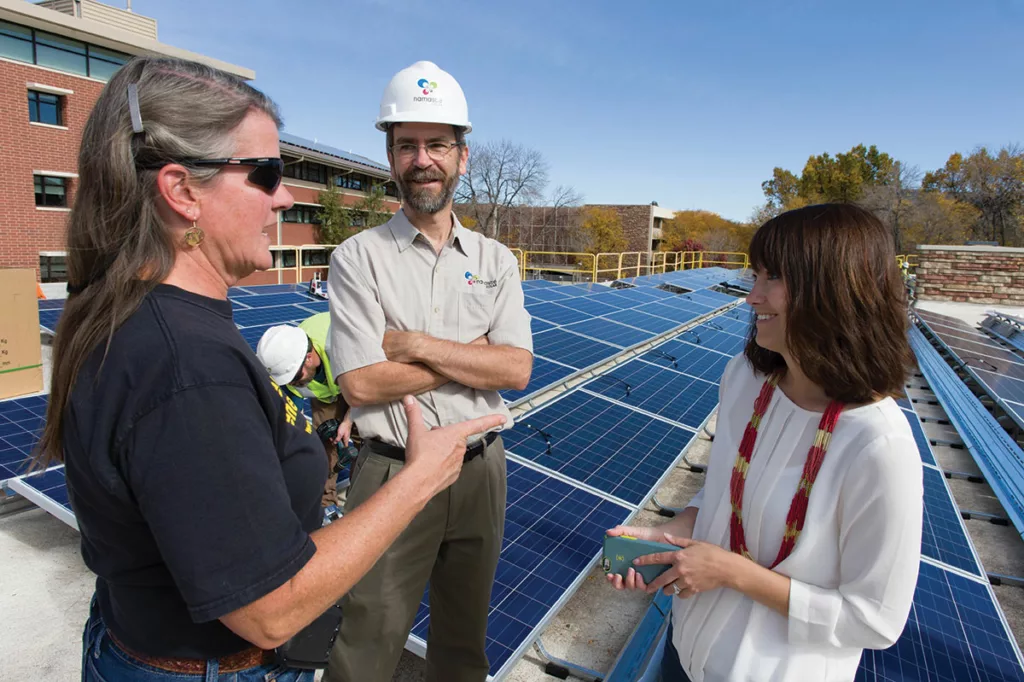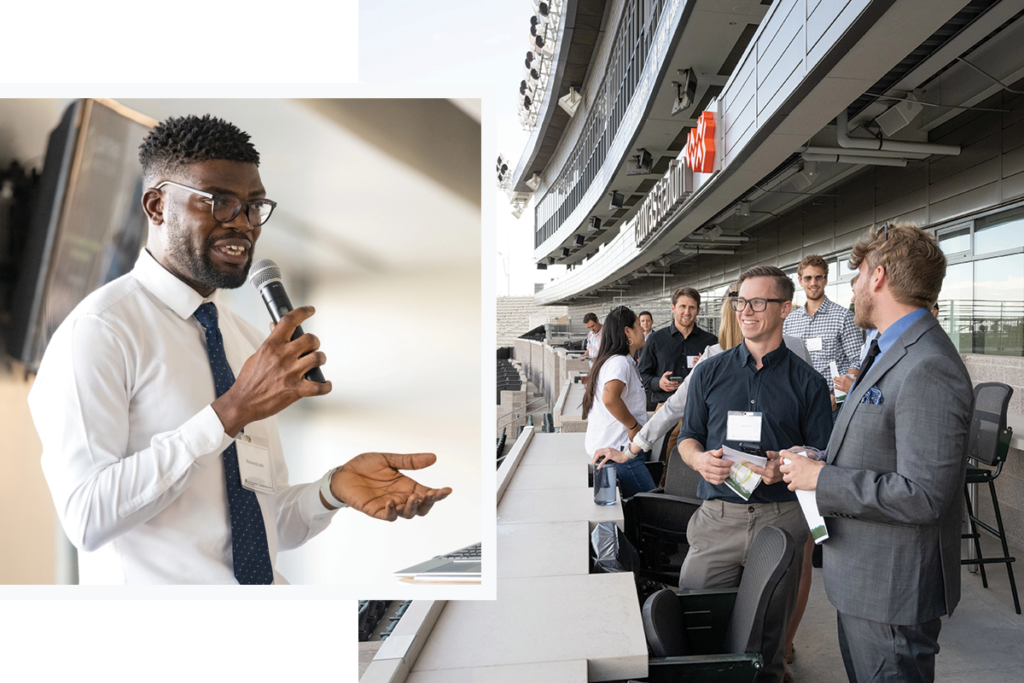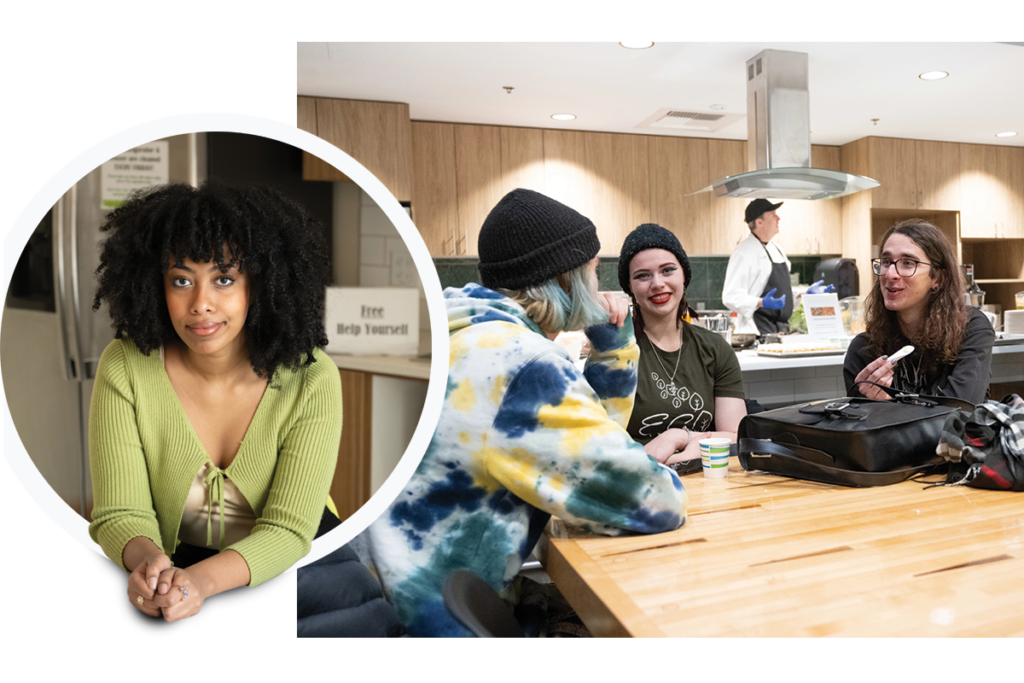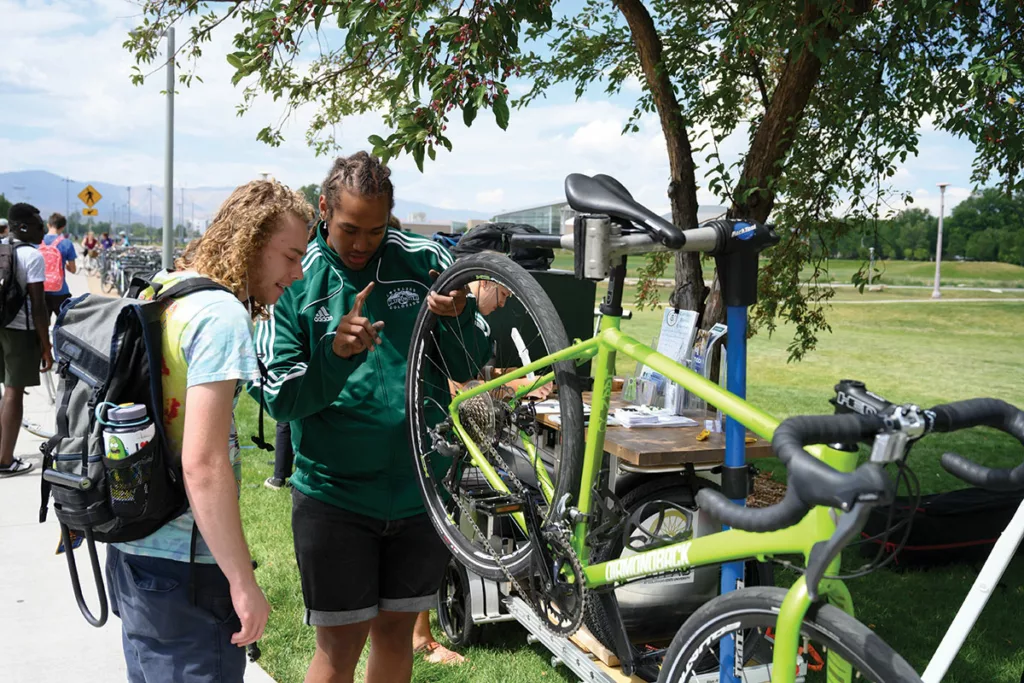With the crowd noise swelling in Canvas Stadium, the team huddles and talks through the game plan. “We rally and get each other pumped up, and then … we put on our vests and each some beans and tomatoes,” said Rachel Lilley, a senior from Colleyville, Texas, studying natural resource management and restoration ecology.
The vests are neon green, the tomatoes are not a sideline snack (yet), and Lilley is the social media coordinator for Colorado State University Zero Waste Team. On game days, members of the student-led organization gather at a nearby food and pollinator garden before heading into the stadium.
As the Rams drive the football up and down the field, Lilley and other students move around the stadium, “top-sorting” half-eaten pretzels and nachos into composting bins and sticky aluminum cans into recycling bins to divert food waste and other materials from the landfill. They also talk with fans about how to sort their trash as they approach waste stations, and why a group of students happily paddle through garbage at campus events.
“We’re seeing more sustainable choices,” said Lilley, mentioning that a few stadium vendors have switched to compostable or recyclable materials. Even more encouraging, CSU stadium and event crowds – not typically known for their trash-tossing etiquette – are going out of their way to sort their waste.
“People ask us which things go where, and it keeps getting better,” said Sam Cummings, the Zero Waste Team president and a third-year student from Florissant, Colorado, studying chemical and biological engineering. “We’re here to make sustainability approachable.”

Sustainability is everywhere
It’s hard not to approach sustainability on the CSU campus. There are the tomato patches and wildflowers in the food and pollinator gardens. Compost-only receptacles just for paper towels are in nearly every campus restroom. Solar arrays sit on the roofs of more than three dozen buildings. New buildings, such as the Nutrien Agricultural Sciences Building, use sustainable materials and design to minimize energy use. “Living walls” literally grow inside the Michael Smith Natural Resources Building and other campus facilities.
Other green achievements are not so obvious. Anyone on the intramural fields next to Moby Arena would likely be unaware they are standing above a massive geothermal energy-exchange system that has significantly reduced CSU’s carbon emissions. Known as Moby GeoX, the $20 million project completed in 2020 now uses geothermal energy to heat and cool Moby, replacing carbon-intensive steam heating and chilled-water cooling systems.
Since the turn of the 21st century, CSU’s initiatives, innovations, and enthusiasm for sustainability have transformed how the campus operates and how the campus community behaves. Bold strategies and steps have made CSU a trailblazer in sustainability efforts while also earning the school top ranks and awards.
Colorado State was the first university to receive a Platinum rating from the Sustainability Tracking, Assessment and Rating System of the Association for the Advancement of Sustainability in Higher Education in 2015. Since then, CSU has earned the highest rating on the biennial STARS assessment four consecutive times, helping to raise the bar among global peers for sustainability research, academics, and operations. There were 12 Platinum-rated universities in 2022, when CSU earned second in the overall STARS Sustainable Campus Index Rankings for doctoral institutions.
All in on renewable energy
STARS and other accolades have helped establish CSU as an institutional leader, but there’s another set of numbers to focus on: The University has pledged to run on 100% renewable electricity by 2030 and, in 2021, moved up its goal for campus carbon neutrality to 2040 – 10 years ahead of previous plans.
“I’m proud we’re Platinum, but I don’t worry whether we get a higher [STARS] score,” said Carol Dollard, CSU’s energy engineer who leads many of the climate-action and sustainability programs and initiatives.
“Campus sustainability is embedded everywhere at the University,” she said. “No matter where you look, folks are working to make our institution better: teaching our students to make them more aware, trying to solve a research puzzle to improve sustainability everywhere, or just trying to reduce the climate impact of our operations.”
Dollard came to CSU in 1978 as a student interested in studying alternative energy before sustainability became a buzzword.
“It was one of two schools [in the nation] that offered solar engineering,” she recalled.
Dollard completed her bachelor’s and master’s degrees in mechanical engineering at CSU during the 1980s, stuck around Northern Colorado, and eventually accepted a position with the University in 1999. During the first years of her job, Dollard helped manage CSU’s energy and water demand, including early efforts at tracking campus carbon-dioxide emissions.

Part of the land-grant mission
From its establishment, CSU has trained people to manage natural resources. Founded in 1870 as a land-grant university, the school has always offered accessible education in agriculture, engineering, and the sciences. This land-grant mission manifested into the CSU Extension Service, with offices in every county in Colorado, to provide guidance to farmers, ranchers, landowners, and managers on conserving energy, food, water, and natural resources in the arid West.
“CSU started with outreach, and with educating people in agricultural practices and water use,” said Tonie Miyamoto, director of communications and sustainability in the Division of Student Affairs. “Sustainability is in our blood because of our land-grant mission.”
The rise of programs in ecology, wildlife and recreation management, and renewable energy engineering in the 1960s was a natural progression as the U.S. environmental movement came of age.
By the mid-2000s, CSU’s green sheen was gaining national attention and recognition from the Sierra Club, Newsweek, and Chronicle of Higher Education, but meaningful efforts toward campus climate action and decarbonization were just beginning.
Two milestones marked 2008 as a watershed year for campus, one for operations and one for education.
“Sustainability is in our blood because of our land-grant mission.“
Tonie Miyamoto
Director of Communications and Sustainability, Division of Student Affairs
The first milestone was when CSU President Larry Penley signed on to the American College & University President’s Climate Commitment. Joining more than 300 schools and colleges already in the initiative meant a stepped-up commitment to develop a climate-action plan – a set of goals for campus carbon neutrality. A team representing constituents from across the University came together to develop the first Climate Action Plan in 2010, putting the University on a path to carbon neutrality by 2050.
A second goal, established in 2017 and advocated by students and Penley’s successor, President (now CSU System Chancellor) Tony Frank, was to run campus on 100% renewable electricity by 2030.
“That’s when sustainability efforts really ramped up,” Dollard said.
In 2020, under President Joyce McConnell, the University, with support from the President’s Sustainability Commission, moved the carbon-neutral goal up to 2040, citing evolving technology and institutional will to combat climate change.
Embracing the challenge
Leaders in Facilities Management, Housing & Dining Services, the Institute for the Built Environment, and other units embraced the challenge. Dollard and colleagues began taking a harder look at infrastructure upgrades and changes, power plant operations, water and energy efficiency, building materials and designs, the overall health and safety of campus, and ways to reduce and offset carbon emissions.
The first campus solar array was installed atop the Engineering Building in 2009 and still produces 18.9 kilowatts, enough to power a few homes. Many more arrays have followed. In October 2022, the University celebrated a benchmark of 20 new solar arrays over a two-year period, which collectively produce 4,200 kilowatts of electricity, enough to power 800 homes.
Housing & Dining tackled the sustainability goals through building renovations and new construction. Eight new residence halls have earned Leadership in Energy and Environmental Design or LEED certification for use of sustainable materials and design since 2010, and upgrades have improved buildings’ energy efficiency. The department has also adopted practices to increase recycling and composting in dining halls and to serve food grown on campus by CSU students.
Large and groundbreaking – both literally and in terms of carbon savings – projects, such as Moby GeoX, have come to fruition in the past decade through advocacy and persistence. The geothermal exchange was first proposed in 2013 but wasn’t completed until 2020.
“It’s not that [administrators and lawmakers] are saying no, we just have to wait on the money,” said CSU campus energy coordinator Stacey Baumgarn. After all, $20 million requests for energy efficiency and carbon reduction must also compete for funding with other campus needs.
“Decarbonizing a campus is hard and slow,” Baumgarn said, “but we have made leaps and bounds and implemented projects that didn’t even exist five or 10 years ago. It’s been transformational.”

The rise of SoGES
The second milestone of 2008 was the establishment of the School of Global Environmental Sustainability, known as SoGES (“SO-jez”). Following the recommendations of a 14-person task force, Penley and then-Provost Frank founded the school as an interdisciplinary, cross-college program that provides classes and a minor in global environmental sustainability with focused tracks on sustainable water, peace and reconciliation, and sustainable energy.
“CSU and the people here were already known for working on these challenges with wildlife, ecology, and the environment, and for our work globally,” said University Distinguished Professor Diana Wall, SoGES director and professor of biology, who was not a member of the 2008 task force. “The task force recognized this was something we excel at across so many issues and departments, and we needed a structure.”
In creating SoGES, CSU leaders and faculty acknowledged that the fields of sustainability and the environment require insight and expertise from scholars and practitioners in science and natural resources as well as engineering, humanities, business, social sciences, education, and beyond. Most affiliated faculty who teach and develop SoGES courses remain employed by another department or college. The detached and decentralized model has served to build collaborations among faculty, students, and disciplines to study, teach, and learn about sustainability.
In addition to the undergraduate minor, “SoGES has brought to the forefront the really interesting research and engagement that people are doing on sustainability on a global basis,” said University Distinguished Professor Kathleen Galvin, assistant director of educational programs for SoGES and professor of anthropology.
For example, the school provides annual funding for proposals from Global Challenge Research Teams to study interdisciplinary solutions on environmental issues. Applicant groups typically include CSU faculty, students, and staff across multiple units.
The Africa Center, which Galvin directs, and the Center for Environmental Justice are now established units forging into engagement and research; both began as SoGES-funded proposals. The school’s Sustainability Leadership Fellows program trains Ph.D. and postdoc students in science communications and outreach. Sustainability Curriculum Innovation grants enable faculty to integrate sustainability curriculum into existing courses and develop new and experimental courses.
Infused into every college
Sustainability is now infused as lesson content across all eight CSU colleges. A 2022 faculty survey found 600-plus classes that address sustainability, many from an environmental, economic, and social perspective.
“In [the Walter Scott, Jr. College of] Engineering, we are never just looking at a topic, we are trying to solve problems,” said the Zero Waste Team’s Cummings. “You’re not just here to learn about engineering, or forestry, or liberal arts. Sustainability is part of it.”
The College of Business requires all business majors take a one-credit Foundations of Sustainable Enterprise class. The college also offers the Impact MBA, a nationally and globally recognized graduate degree focused on sustainable business and social responsibility, rooted in the ideal that business can be a force for good.
“We’re one of the few business colleges in the country that have a required sustainable business course as part of our undergraduate curriculum,” said sustainability initiatives specialist Grace Wright, an Impact MBA instructor and herself a 2013 Impact MBA graduate.
The 16-month-long program, which graduated its 15th cohort in 2022, prepares individuals to fulfill key and emerging roles in industry, business, and real estate at a time when corporations, nonprofits, governments and – clearly – universities are growing to operate in greener and more efficient and environmentally minded ways. The Corporate Sustainability Fellowship Program places students in sustainability positions at Ball Corp., Leprino Foods, and other large and small local companies; in just two years, students have logged 22,000 hours in these roles.
Students specifically interested in carbon management can pursue a certificate through the Department of Ecosystem Science and Sustainability in the Warner College of Natural Resources.
“I’ve realized we’re truly exceptional,” said Wright. “We’re a global leader, but people [at CSU] are not saying, ‘Good job! We did it!’ The commitment is to looking at how can we be even better.”

Small things with big impact
Sustainability, of course, isn’t just a classroom learning objective.
Mercy Abate, a second-year psychology major, is one of more than a dozen Eco Leaders who live in CSU residence halls and campus apartments as green ambassadors encouraging environmentally responsible behaviors. First established in 2011, students selected to be Eco Leaders take a mandatory course during the year that covers peer mentoring, sustainable behaviors, and other topics, and agree to engage with fellow students five hours a week. On a random week in the Aggie Village apartments, Abate may answer neighbors’ questions about what can and can’t be recycled or how much solar energy CSU makes, but “we want to take it a step further and get people involved.”
“By making our students aware of sustainability, they can take that with them after they graduate and make a difference in the broader world.“
Carol Dollard
Utility Engineer, CSU Facilities Management
Clothing swaps and food-sharing, organized by Eco Leaders and partner groups, are a few examples. Abate said a “freege” – a common-area refrigerator stocked with free items – in Aggie Village allows people to share food before it spoils or provide a meal for someone who may not be able to afford it. There’s a permanent Rams Against Hunger food pantry in the General Services Building and pocket pantries all across campus.
“Sustainability really shouldn’t be a question. It’s about not overconsuming and not leaving out people with less or without. That was what encouraged me to be an Eco Leader,” said Abate, who was born in Ethiopia and grew up in Aurora, Colorado. “As Eco Leaders, we focus on the small things that make a big impact.”
“With sustainability, we think about infrastructure and energy, but it’s also about equity and access and environmental justice,” said Mary Liang, assistant director of Sustainability with Housing & Dining Services, who helps manage the Eco Leaders program, “and that comes back to student engagement.”
Living the green life
Student engagement can start from the ground up – literally. In 2010, administrators and students launched a pilot project where students learned how to mix and make compost at a large scale – not in a classroom but amid heaps of earth and dining-hall food scraps. Students didn’t mind getting dirty, and the project yielded measurable results.
“It was an evolution that started us thinking on campus,” said Miyamoto.
The result is the Living Labs that connect students’ lessons about sustainability in the classroom with real-world experiences.
Interns at the Earth Flow Living Lab at the Foothills Campus load and measure a ton of pre-consumer food waste per day into “Oscar,” a large in-vessel composting system. The program diverts 300,000 pounds of food waste from the landfill each year while creating compost available for campus landscaping and sold to the public through CSU Surplus Property.
Through Campus-Grown Greens, a Living Lab launched in 2017, students have planted, harvested, and served more than 6,300 pounds of salad greens and other produce in dining halls. In the Horticulture Center south of campus, students learn to grow foods in hydroponic garden systems and other aspects of food production and management with support from instructors in the Department of Horticulture and Housing & Dining. Another Living Lab is dedicated to raising bees and harvesting honey used in dining halls and for educational programs.
At The Spoke, students learn and practice bicycle mechanics and maintenance and offer no-cost repairs – an incentive to get campus members to ride bikes regularly instead of driving. Students in the program have fulfilled nearly 20,000 service orders since 2014.
“It matters that we teach students outside the classroom,” Miyamoto said. “Our level of collaboration is incredibly high” – one of the benefits of CSU’s decentralized approach to sustainability. “Our leadership, our faculty, our students all care. Yes, sustainability is in our [institutional] strategic plans but our students are also bringing initiatives and ideas and petitions that push us forward.”

Goals for the future
For all the momentum, innovation, and engagement, CSU is not guaranteed to meet its 2030 renewable-electricity goal or its 2040 carbon-neutrality target. A significant portion of the University’s energy still comes from natural gas. Climate change isn’t going away, and there are still many areas for improvement and upgrades.
One potential game-changer would be replacing existing gas-powered, steam-driven, carbon-intensive infrastructure with a large heat-pump system that moves hot water beneath campus to heat buildings and facilities. A wholesale upgrade could lower CSU’s carbon footprint by 15% to 20%, Dollard said, but would also likely cost more than $100 million and require major construction.
CSU is also studying campus transportation habits and transit options to reduce gasoline consumption.
Baumgarn and others, however, remain focused on the “small actions” that do not warrant media attention or earn awards on their own, such as timers on equipment using electricity, efficient light bulbs and low-flow toilets, increased numbers of campus shuttles and recycle bins, more spur-of-the-moment chats about waste diversion or clothing upcycling.
Dollard noted that CSU has grown its campus population and building footprint steadily in the last 15 years yet managed to keep its energy consumption at nearly the same level.
After years of completing assessments and earning top marks through STARS, “how we educate our students is more important than how we operate,” Dollard said. “Our students are passionate about sustainability, and they are doing great things because we have built an infrastructure to make ‘good choices.’ By making our students knowledgeable and passionate about sustainability, they can take that with them after they graduate and make a difference in the broader world.”
“When I came to CSU and heard about the Zero Waste Team, I thought, ‘I have to join!’” said social media coordinator Lilley. “I’m all about tangible results, and we want to be examples for students and other campuses too. We just got a message from a student at another university saying, ‘I wish we did something like this. “I wrote back, ‘You never know what you can do.’”

Students for Sustainability
According to the Office of Admissions, nearly 13% of the incoming class of Fall 2021 cited “Environmental and Sustainable Initiatives” as a top interest, and CSU offers all students the opportunity to be involved in meaningful sustainability research and education.
Zero Waste Team
With 50 active members, the Zero Waste Team brings together students dedicated to reducing waste on campus to help properly dispose of waste at athletics events, Ram Welcome, Ag Week, and more.
Eco Leaders
Student leaders in the residence halls that help foster a culture of sustainable behavior by educating residents on compositing, energy conservation, food security, and more.
SkiSU
By providing round-trip transportation for students to destinations like Copper Mountain, Winter Park, Steamboat, and more, the SkiSU bus helps save on vehicle emissions throughout the ski season.
Student Sustainability Center
Half resource center, half club, the SSC supports student-led clubs, teams, and projects working on solutions to sustainability issues on campus and in the community.
Patchwork Initiative
A campuswide initiative led by students with goals of reducing clothing consumption, growing a culture of slow fashion, clothing restoration, and educating community members and students.
Nitrogen Footprint Project
Student-led project that sets out to track the nitrogen use of CSU’s campus, placing CSU among the world’s first institutions to calculate its nitrogen footprint.
Read more about the Student Sustainability Center. ONLINE: col.st/fxbKy
Research by Hope Terrini, icon design by Mia Rivero